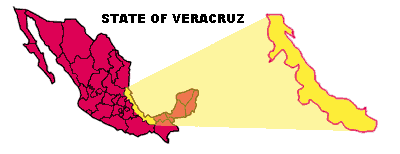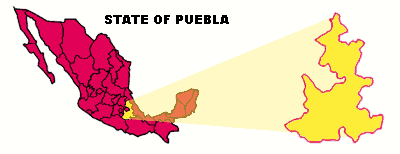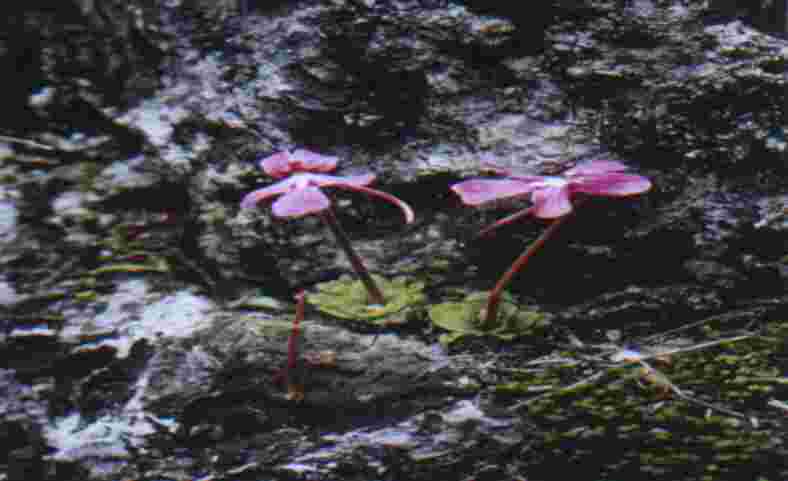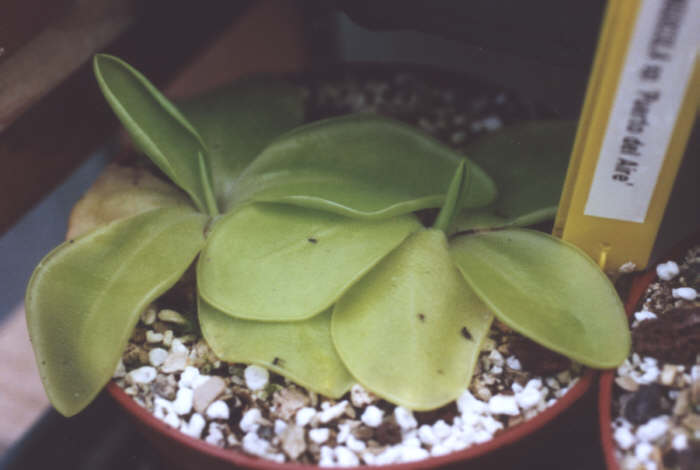Pinguicula moranensis var.
neovolcanica
' Puerto del Aire '
go to : Home
index of species
TAXONOMY:
Family :
Lentibulariaceae
Genus :
Pinguicula
Name : Pinguicula moranensis
var neovolcanica
Sub-classification
(Casper)
: link
Publication :
Not yet officially published
but mentioned in the "International Pinguicula study group",
Newsletter N°7, January 1996, pages 3 to 4, "Pinguicula hunting in
Mexico" by Ing. Z. Yezek (See extract below).
Synonyms : Pinguicula
sp. ' Puerto del aire '
DESCRIPTION :
-
Soon -
ORIGIN AND HISTORY :
Mexico, from Puerto del
Aire.
Extract from "International Pinguicula study group", Newsletter N°7,
January 1996, pages 3 to 4, "Pinguicula hunting in Mexico" by Ing. Z.
Yezek.
"One day, just before my
departure, I was returning from the town of Orizaba to my Hotel in Tehuacan by
bus. The road winds through the famous saddle Puerto del Aire. This locality in
itself would be worth a separate article because of its exceptional feature and
beauty. It creates a border between the arid tropics (?) of the Tehuacan Basin
and the Atlantic humid climate, which is typical for most of the territory of the
coastal state of Veracruz, in the altitude of around 2000m. The bus crawl up the
serpentines at the steepness unseen back home. A botanist hanging on a handle in
a overcrowded bus, and looking over the heads of his luckier co-passengers, has
enough time to study the vegetation along the road, which changes very quickly
as we reach a higher altitude. From that position, I suddenly caught a glimpse
of familliar Pinguicula blossoms, which I could not mistake for anything
else ! They were bigger and more colourful that anything I had seen before.
I had to go back the next day. There were
hundreds of blossoming Pinguicula with a considerable variability of
blossoms. Most specimens blossomed from the winter rosette and only a few had
developed carnivorous leaves. No wonder that I could not find them before; the
rosettes were very small and inconspicuous and perfectly camouflaged with dry
remains of the summer leaves and other shed material. The Pinguicula grew
individually or in small groups in rock crevices, but also in the grass partly
shaded by low shrubs. The slope face south-east and it was so steep that it was
difficult to stand on it. I was surprised by the water conditions at the
locality; it was very dry, and although the dry season was coming to an end, the
composition of the surrounding vegetation did not suggest any significant
improvement during the rain season. The humidity was not high either, epiphytes
still occurred only rarely. In our collection, we usually torment Pinguicula in
water all year round, while here the soil could never get soaked (note the
steeples and the exposure of the slope). The composition of the soil resembled
the soil of our alkaline mountain meadow in the altitude of 800m. and above. I followed this experience when
I tried to implant the imported specimen in the
growth at home and they have been growing well so
far."
Map /
LOCALISATION:
No precise localisation but according to the
text, the plants grow near the road between Orizaba to Tehuacan near Puerto del Aire. As
we cross the limite between two Federal states (Veracruz for Orizaba and Puebla
for Tehuacan, Puerto del Aire can be in one of this state or at the limit
between the two states.
(click
on the map for better location and
relief map)


HABITAT:
The Pinguicula grew
individually or in small groups in rock crevices, but also in the grass partly
shaded by low shrubs. The slope face south-east and it was so steep that it was
difficult to stand on it. I was surprised by the water conditions at the
locality; it was very dry, and although the dry season was coming to an end, the
composition of the surrounding vegetation did not suggest any significant
improvement during the rain season. The humidity was not high either, epiphytes
still occurred only rarely. In our collection, we usually torment Pinguicula in
water all year round, while here the soil could never get soaked (note the
steeples and the exposure of the slope). The composition of the soil resembled
the soil of our alkaline mountain meadow in the altitude of 800m. and above.
Introduction in culture
:
The plant have been brought in culture by
Ing. Z. Yezek around 1996. I get one clone in 1999.
CULTURE
AND MULTIPLICATION :
(North
hemisphere, France
near Paris, in a polycarbonate greenhouse - see the map
-)
Life
cycle :
The
life cycle observed in culture for this Pinguicula
consists of two seasons, one wet and the other dry (see link). The plant forms different
leaf rosettes according to the season. During the resting months (winter) the
small succulent rosette is composed of numerous non-carnivorous leaves. The
carnivorous leaves are produced in spring and during all summer. The life
cycle of the plant is probably similar in it's native habitat.
Media
: I use a 100 % mineral media :
2 perlite, 2 vermiculite, 1 small sand (for aquarium), 1 fine white sand, 1
pouzzolane (volcanic lava), 1 aqualit (expansed ceramic for aquarium). The
aqualit can be replaced by 1 of pouzzolane. Plants in this media grow slower
but have a stronger root system.
Pot
: plastic,
colour terracotta, diameter 12.5cm, height 12cm.
Cultivation
:
I
think that a slightly airy situation inside the greenhouse is important
to avoid air stagnation. For this reason, I use a fan 24h/24h all the year
round.
Watering
is very important : from
May to September (summer). I let the media drying slightly between two watering. I use rain water poured on the top of the pot taking care
not to wet the rosette. From October to April, It is important to let
the media drying completely (no watering) but with an atmospheric humidity of
about 80%.
The mentioned months are indicative and can change
according to your own growing conditions. In fact, when this Pinguicula
begins to produce its non-carnivorous leaves, you have to stop watering and
let the pot drying out completely. Inversely, when the plant begins to produce
in early spring its carnivorous leaves, you have to progressively start
watering again the pot.
Temperatures : during
growth period, day temperatures are about 25°C but can reach 35°C when the
sun is shining on the greenhouse in spite of the use of shading covers.
Night temperatures are around 20°C. During
resting period : day/night over freezing point. Lower temperature
observed : - 4°C. I use an electronic petroleum heater to provide heat.
Flowering
period : not yet.
Multiplication
:
I have never succeeded in pollinating the flowers of this Pinguicula. So I don't
know the seeds. The plants can be propagated easily using non-carnivorous
leaves separated from the rosette at the end of winter. You only have to carefully
tear out the totality of the leaf including the white base as the plantlets
will sprout from this area.
PICTURES: (click to
enlarge)
|

Pinguicula
moranensis from
'Puerto del Aire' in nature flowering
from winter rosette.
Photo: Ing. Zdenek Jezek in
IPSG, N°7.
|

Pinguicula
moranensis from 'Puerto del
Aire' in culture summer rosette
Photo: Eric
Partrat
-
November 02 -
|
|
.jpg)
Pinguicula
moranensis ' Puerto del Aire ' in culture young winter
rosette.
Photo: Eric Partrat
|
.jpg)
Pinguicula
moranensis ' Puerto del Aire ' in culture adult winter
rosette.
Photo: Eric Partrat
|
|
.jpg)
Pinguicula
moranensis ' Puerto del Aire ' in culture adult winter rosette.
Photo: Eric Partrat
|
|
|
.jpg)
Pinguicula
moranensis ' Puerto del Aire ' flowering from winter rosette in culture.
Young emerging flower bud.
Photo: Eric Partrat
|
.jpg)
Pinguicula
moranensis ' Puerto del Aire ' flowering in culture. Flower bud before
opening. Note the Hairy glands covering all parts of the flower including
scapes, corolla lobes...
Photo: Eric Partrat
|
|
.jpg)
Pinguicula
moranensis ' Puerto del Aire ' flowering in culture.
Photo: Eric Partrat
|
.jpg)
Pinguicula
moranensis ' Puerto del Aire ' flowering in culture. Note the long
spur.
Photo: Eric Partrat
|




.jpg)
.jpg)
.jpg)
.jpg)
.jpg)
.jpg)
.jpg)